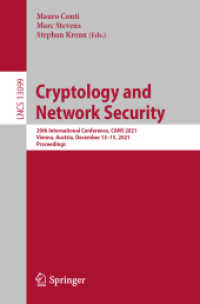Full Description
Pulmonary embolism is the third most common cause of cardiovascular death, accounting for 60,000 to 100,000 deaths in the United States annually. The PERT Consortium, an international multidisciplinary professional society, was formed in 2015 with the goals of advancing clinical, educational, and research activities to advance the care of pulmonary embolism worldwide.
There is no single authoritative reference source dedicated to pulmonary embolism. This handbook fills a major gap in reference needs for pulmonary embolism and will be attractive to a broad audience from students and clinicians to advanced researchers.
The handbook consists of 8 sections, averaging 6 to 12 chapters per section. Each section's chapters are written by PERT Consortium members reflecting the consortium's dedication to its goals of advancing PE care. This book spans from basic science, to clinical care and research practice related to PE and is, thus, comprehensive in scope and multidisciplinary in its appeal.The PERT Consortium Handbook is for any medical professional who has an interest pulmonary embolism including cardiologists (general and interventional), emergency medicine physicians, hematologists, pulmonary and critical care physicians, radiologists (general and interventional), surgeons (cardiovascular, thoracic, and vascular), and as well as pharmacists, advanced practice practitioners (physician assistants and nurses), post-graduate trainees, researchers, hospital leaders and administrators, and respiratory therapists.
Contents
Acute Venous Thromboembolism: A Historical Perspective.- Epidemiology of Pulmonary Embolism.- Cardiopulmonary Anatomy.- Right Ventricular Physiology and Pathophysiology in Acute Pulmonary Embolism.- Pharmacology of Hemodynamic Support in Acute Pulmonary Embolism.- Overview of the Coagulation Cascade and Thrombophilic Disorders.- Pharmacology of Anticoagulation.- Systemic Thrombolytic Therapy for Acute Pulmonary Embolism.- History and Physical Examination in Pulmonary Embolism.- Pulmonary Embolism Index of Suspicion: Adding Data to Gestalt.- To PE Or Not To PE.- CT in Pulmonary Embolism.- Lung scintigraphy in the diagnosis of pulmonary embolism.- Lower Extremity Venous Ultrasound in the Diagnosis, Treatment, and Follow- Up Care of Patientswith Acute Pulmonary Embolism.- Echocardiography and Pulmonary Embolism.- Magnetic Resonance Imaging (MRI) in Pulmonary Embolism (PE) .- Biomarkers and Pulmonary Embolism.- Risk Stratification and Scoring Systems for PE.- Normotensive Shock in Pulmonary Embolism Patients.








